Brown Street Clock Registry
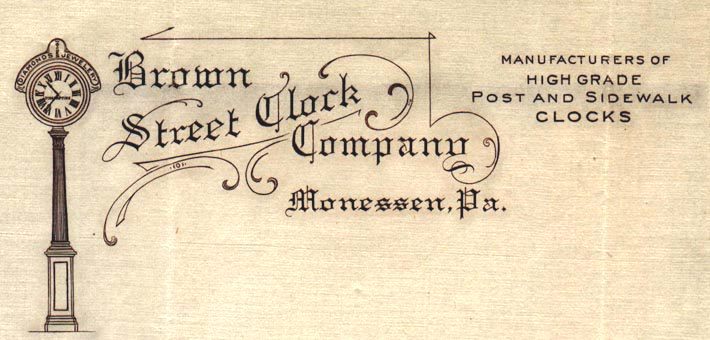
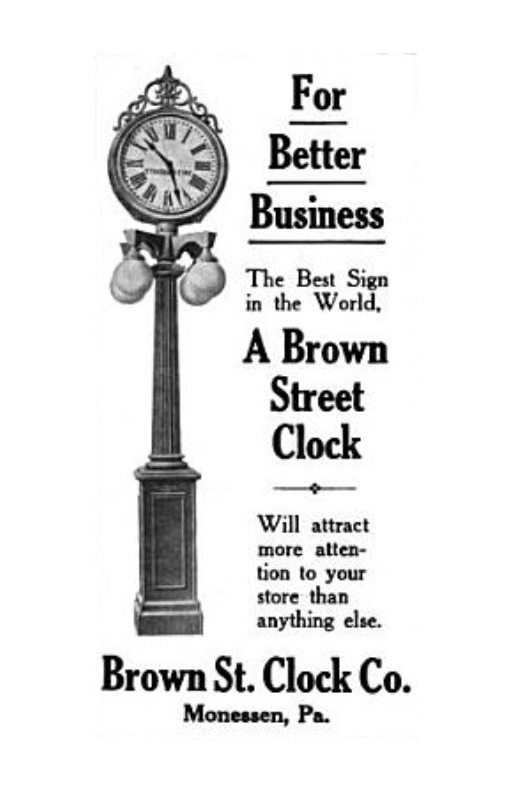


Brown Clock Company records are non-existant, therefore it is hard to determine how many clocks were actually produced and sold. This registry includes approximately 60 known clocks in 2014.
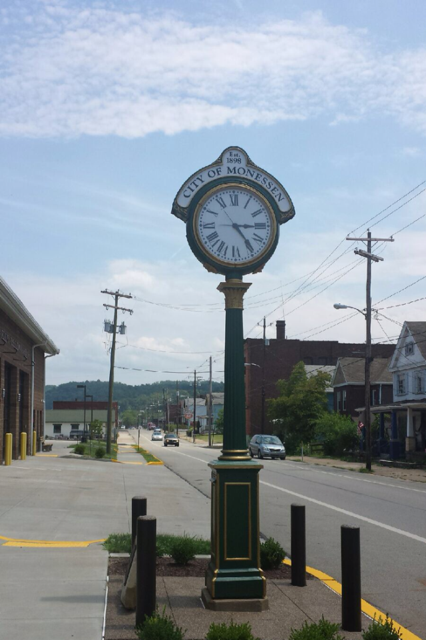
The RED PINS show the early style clock case and YELLOW PINS show the later style clock case
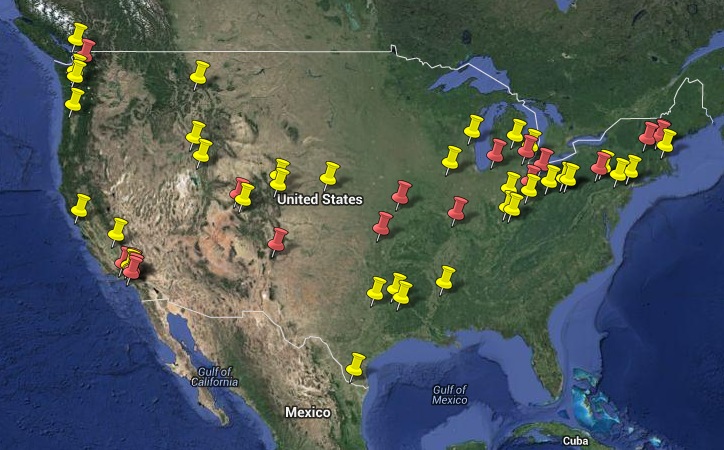
NOTE: Some clocks have been moved from their original installations and some have disappeared altogether.
Please email us if you know of any other Brown clocks:
steveschmidt at hotmail.com
******Alhambra, CA
******Fullerton, CA
******Huntington Beach, CA.......Owned by Stephen Rini...originally from Lindsey's Jewelers of Kansas City, MO
******Monrovia, CA.......Owned by Box Jewelers
*******Orange, CA......... Located in front of Felix's Continental Cafe and "The Flats" on the Orange Circle
*******San Rafael, CA.........Located on 4th Street
*******Visalia, CA
******West Hills, CA.......Owned by Hidden Lake Club House
******Delta, Colorado...........Owned by McKnight's Jewelry
******Denver, Colorado..........Located near 15th & Larimer Streets the 'Market Clock', circa 1910.
******Grand Junction, Colorado.......Page Parsons Jewelers
******Loveland, Colorado......Located Downtown
******Pocatello, Idaho.........Molinelli's Jewelers
******Kewanee, Illinois.......... It is located on the main street in front of a real estate office. It has side lights and the movement has been electrified.
******Murphysboro, Illinois
******Elkhart, Indiana........Owned by Omega Center
******Danville, Kentucky..................Owned by Don Porters
******Frankfort, Kentucky.......M.A. Selbert Jeweler
******Lexington, Kentucky......Skuller's Jewelry located downtown
******Boston, Massachusetts.....Fanueil Hall Market Place
******Oakland, Maryland........Thayerville
******Dearborn, Michigan........Located at The Henry Ford Museum & Greenfield Village
******Grosse Pointe, Michigan
******Owosso, Michigan.............Owned by City of Owosso
******Yazoo City, Mississippi....Anderson's Jewelry Store
******Kirkwood, MO...........Owned by James Willman
******Kansas City, MO.....now located in Huntington Beach, CA....... Owned by Stephen Rini...originally from Lindsey's Jewelers of Kansas City, MO
******Helena, Montana.........Sole Sisters store
******McCook, Nebraska........owned by Carnegie Library Museum
****** Bedford, New Hampshire.......Fidelity Restoration Service - Norman Croan
******Manchester, New Hampshire........St. Anselm College
******Bayonne, NJ......Known as the Abramson's Clock and restored in 2010, it is located at 484 Broadway St.
******Las Vegas, New Mexico
******Charlotte, NC........Located downtown Charlotte.....moved from Cleveland, NC
******Salisbury, NC........originally from Winston-Salem, NC.....unknown location today
******Winston-Salem, NC.......later moved to Salisbury, NC.......unknown location today
******Bartlesville, Oklahoma
******Barnesville, Ohio.........Located Downtown
******Chillicothe, Ohio........owned by Crosskeys Tavern
******Cleveland, Ohio.................now located in Charlotte, NC
******Columbus, Ohio............Owned by the COSI Science Center
******Hicksville, Ohio.......Hart Brothers Jewelers
******Medina, Ohio
******Oxford, Ohio..........Restored by the City of Oxford.
******Oregon City, Oregon........Owned by John Pohlpeter
******Salem, Oregon.......Owned by Pomeroy and Keene
******Bedminster Township, Pennsylvania......Owned by Elmer Conti
******Bloomsburg, Pennsylvania.......Sneidman's Jewelry
******Donora, Pennsylvania ........Unknown today
******Monessen, Pennsylvania......Brown Clock Co. Factory located in Monessen
******Punxsutawney, Pennsylvania
******Scottdale, Pennsylvania........1910
******Sunbury, Pennsylvania.......American Legion Post
******White Oak, Pennsylvania.......Plaza Azteca Restaurant
******Pickens, South Carolina.......Unknown Owner
******Woodruff, South Carolina.......Unknown Owner
******Center, Texas.....Owned by City
******Corsicana, Texas........Privately owned
******Longview, Texas........Owned by McCarley’s Jewelers
******Mission, Texas.........Privately owned
******Logan, Utah
******Brattleboro, Vermont........Owned by the City of Brattleboro
******Blaine, WA......Owned by the City of Blaine.
******Centrailia, WA........Salewsky's Jewelry at 211 N Tower Ave.
******Olympia, WA..........Washington Center for Performing Arts
******Snohomish, WA..........Downtown in front of old bank building
******Cedarburg, Wisconsin
******Watertown, WI.......................Owned by Steve Listle....This clock was originally from Augusta, WI area.
If you know of existing Brown Street Clocks, or have an original factory catalog,
Please use email below.
steveschmidt at hotmail.com
In the early 1900's, several U.S. street clock manufacturers produced various style and sizes of post and sidewalk clocks.
E. Howard Clock Co., Seth Thomas Clock Co., Jos. Mayer Bros. and the Brown Street Clock Co. competed in the 'street clock' market.
The Brown Street Clock Company claimed at one time, 7 of 10 street clocks in the U.S. were Browns.
Whether true or not, the Brown company could sell a jeweler a street clock for as little as $175 in about 1910 and give them credit to boot.
Seth Thomas and E. Howard street clock's sticker price was considerably more money at that time.
This webpage attempts to record all the known Brown Street Clocks that continue to provide service throughout the U.S.
Below is the Brown street clock that stood in front of the Brown Jewelry Store
in Donora, PA between 6th and 7th Streets on McKean Ave.
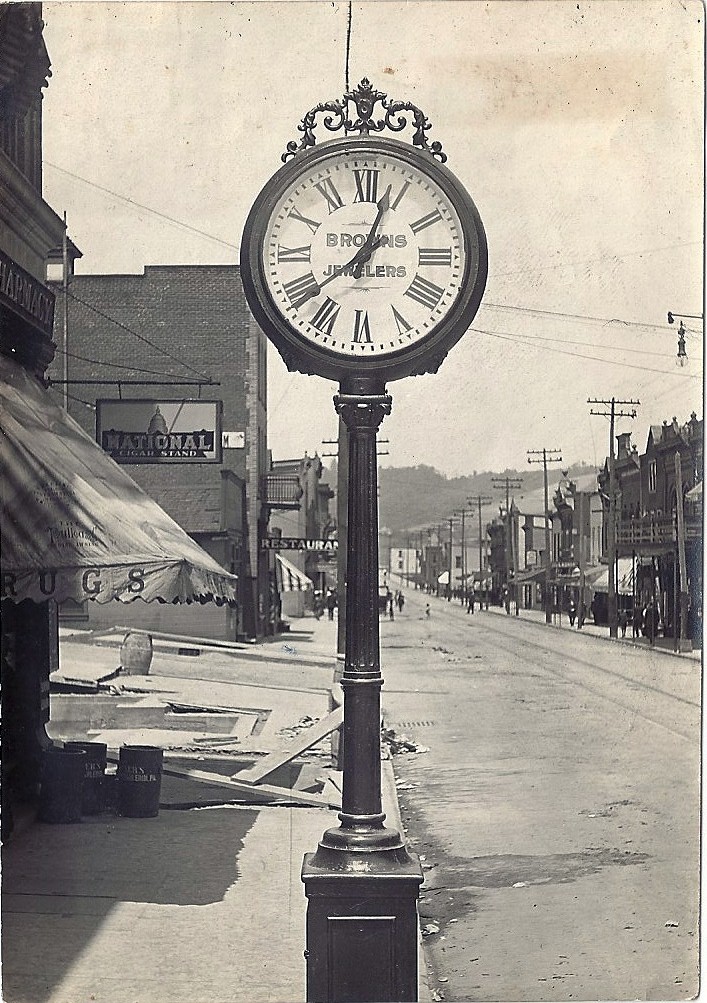
The local paper reported on Dec. 28, 1906 that Benjamin and Walter had purchased a two story brick building on Donner Ave. This partnership split up in Jan. 1911.
A 1909 newspaper article reported the Benjamin had secured an agency of the REO automobile.
According to an article in the Monessen Daily Independent, May 19, 1911, the Brown Street Clock company asked the City of Monessen for a building permit to construct a new manufacturing facility. The company which was located in Donora, PA said that over 200 street clocks had been placed on market at as many points in US and Canada since 1908.
The new plant was designed to “increase the capacity by three times – or one clock a day”. Whether this goal was ever achived is unknown.
Benjamin E. Brown said he held the patent for the desgin and the company would take a street clock to the jeweler's convention later that year in Des Moines, Iowa to be displayed.
According to other articles, Benjamin's youngest son, Kenneth R., did service work on the street clocks through the years, even after the plant closed. He re-painted the cases and dials and serviced the movements. Other employees included a Mr. Craig, who painted dials and Lester Hunter who assisted Kenneth Brown in service.
The old postcard from about 1915 shows the Donner Ave. Brown Street clock
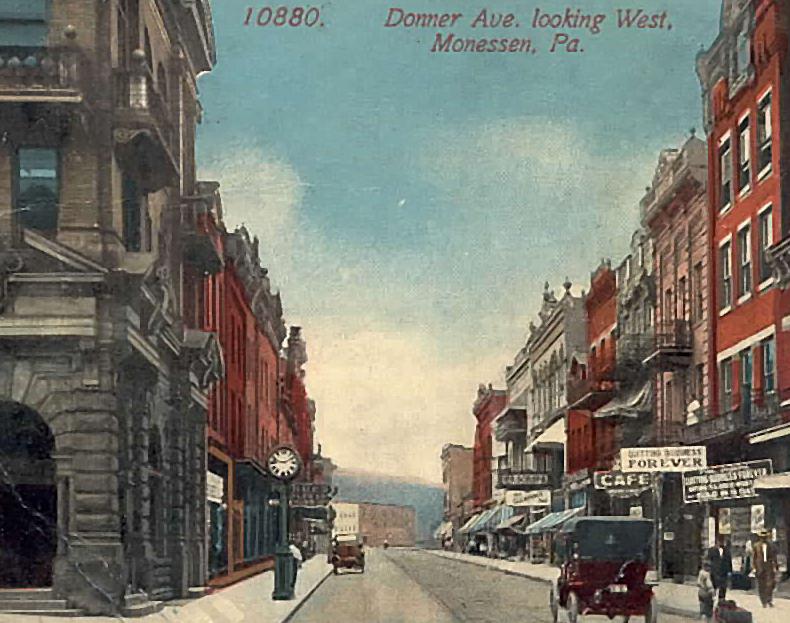
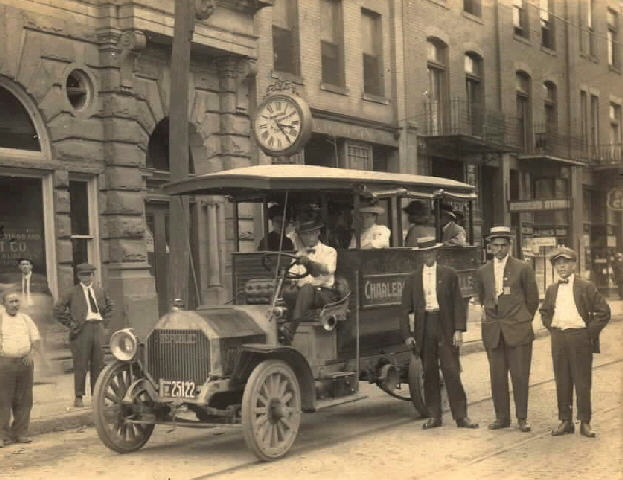
License plate on Republic Truck is a is 1914. Taken in front of Monessen Savings & Trust Bank. The clock is a Brown clock, model #13,400 and is lettered "Monessen Savings & Trust Co."
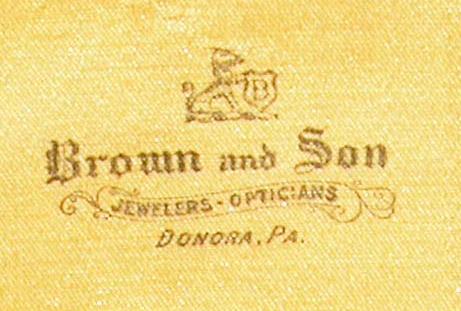
It's an established fact of business that to fix a thing in the public mind it requires on the average, not one but over twenty impressions. Fifty impressions make the fact stick harder. One hundred impressions make it a part of the mind itself.
This is the mission of the Brown Street Clock.
The people see the clock so often - they use it so frequently - they cannot think of clocks or watches or jewelry or even the strip of street on which your store stands without thinking of you.
The Brown Street Clock stamps you as a public spirited citizen who is willing to go right out on the street and serve everybody. This makes a deep impression. The people do not realize just how much of their confidence you have won by this simple service.
They may not resolve this impression into actual words of appreciation, but it is there and the time they want something they will go to you for it just as if they had always been steady customers. Subconsciously, they know that the man that renders unstinted service outside of his store, is going to give them good measure inside.
The Brown Street Clock is the ideal form of advertising - advertising that serves - that gives a man something that he wants. Advertising that instead of blatantly crying its wares once or twice and then stopping, is constantly on the job - establishing the dealers identity - embedding his name in public consciousness, winning for him that confidence and kindly appreciation that is 90% of the business mans assets.
If once you get a Brown Street Clock installed in front of your store, it will pay for itself. We can substantiate this statement by a column of testimonial letters from hundreds of the most progressive jewelers - in fact it would do you're heart good to read some of these enthusiastic testimonials which we are constantly receiving.
If there is anything about our proposition that you do not understand, don't hesitate to call upon us, and remember we give you a broad guarantee with every sale. If you prefer, you can write this guarantee yourself.
That is just how much faith we have in the Brown Street Clock from an efficiency standpoint. Pick out your clock today and we will load it on the next train headed your way.
Swartchild & Company of Chicago, a major jewelers supply company at the time, included in their catalogs the complete line of the Brown Street Clock Company. This form of adveristing more than any other was probably responsible for the large number of Brown clocks being sold to jewelry store operators. Brown Company records are non-existant, therefore it is hard to determine how many clocks were actually produced and sold. This registry includes approximately 60 known clocks in 2014. Our best estimate of total clock production is at about 1,000, as of 2014.
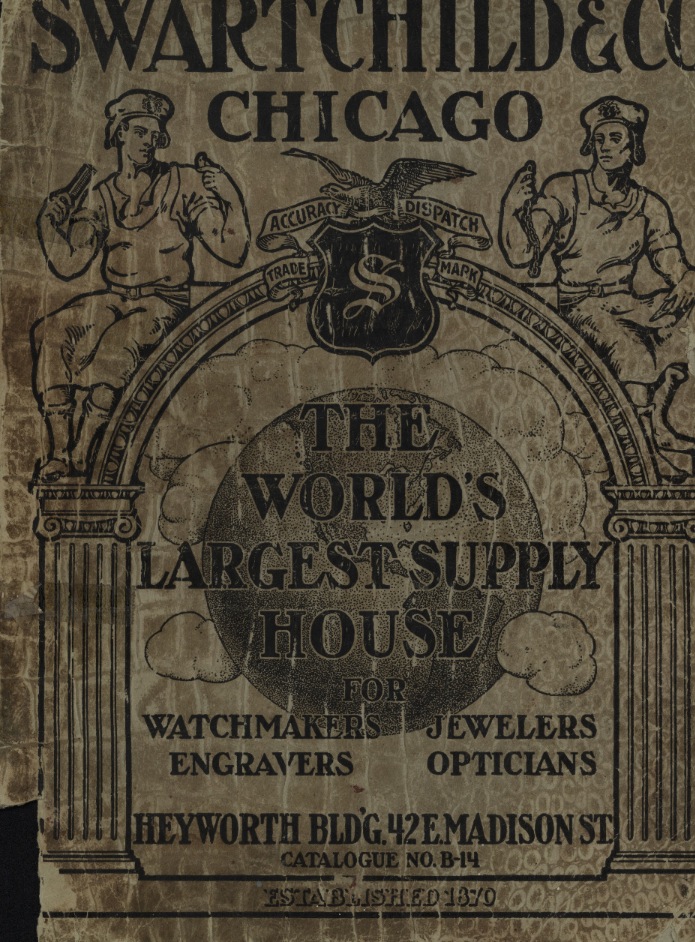
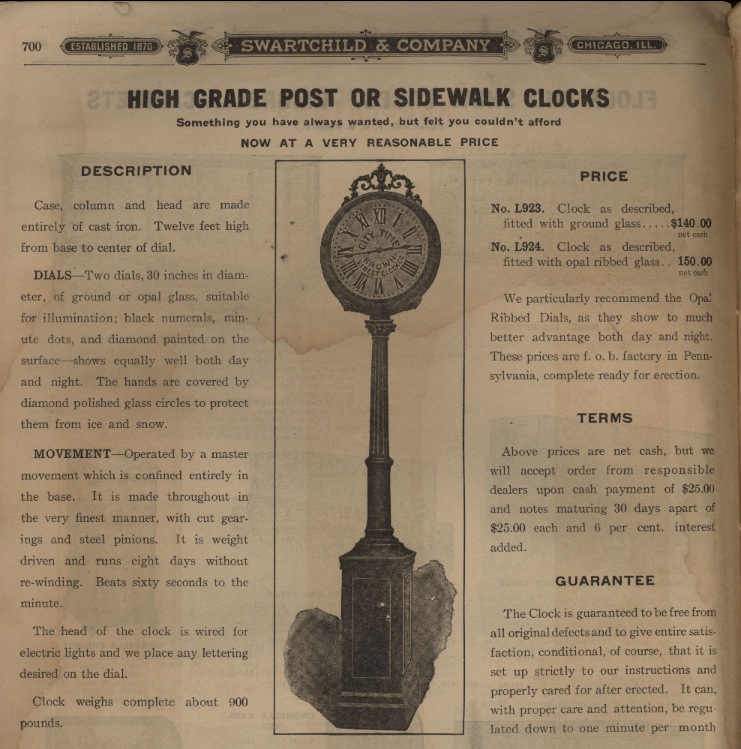

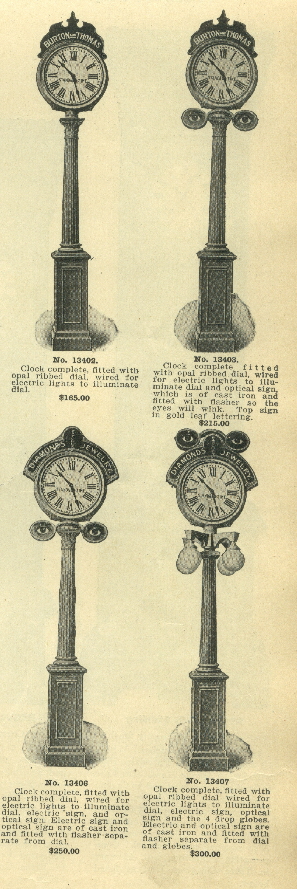
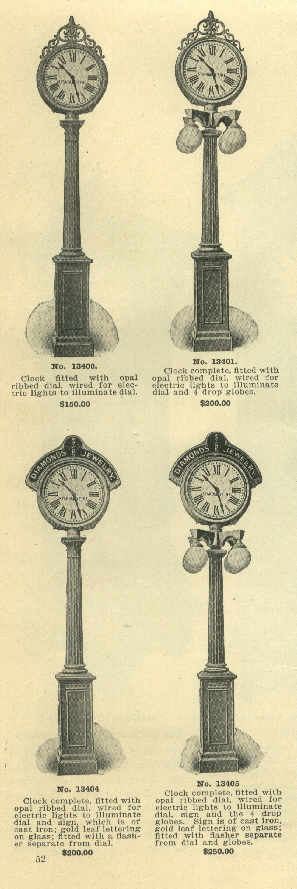
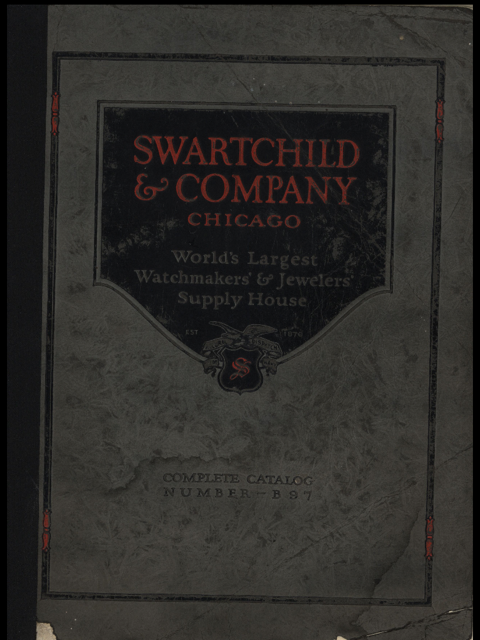
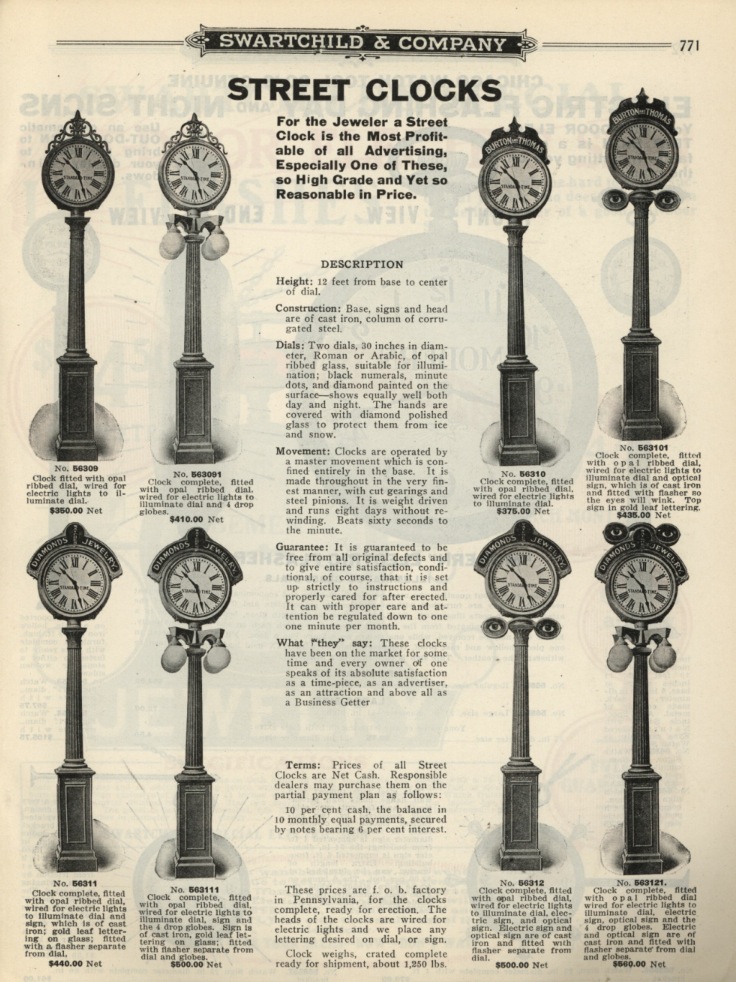
Brown built five different models with tallest being 14 feet, 10 inches. The head and base were made of cast iron and the fluted column of 2-ply, 22 gauge galvanized steel, doric design. These are the later style clock cases which are indicated on the U.S. map with a YELLOW PIN.
The dials were custom designed with the jeweler's name on it. Clock numbers could be ordered with either Roman or Arabic style font.
According to Brown, you could "buy a Brown Street Clock on easy terms - only $15 down - the balance in monthly installments. No interest - no red tape of any kind."
The factory literature stated, "the Master movement is located in the base and runs eight days with one winding. Quality cast brass plates, Graham deadbeat escapement, maintaining power on cable barrel and cast iron motion works mounting bracket."
Electric lights were installed behind dials for illumination and the clock weighed 1,625 lbs. when crated for shipment.
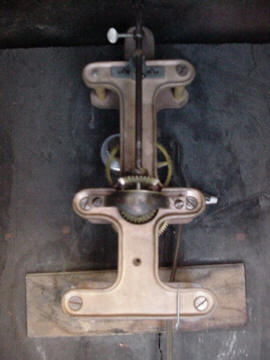
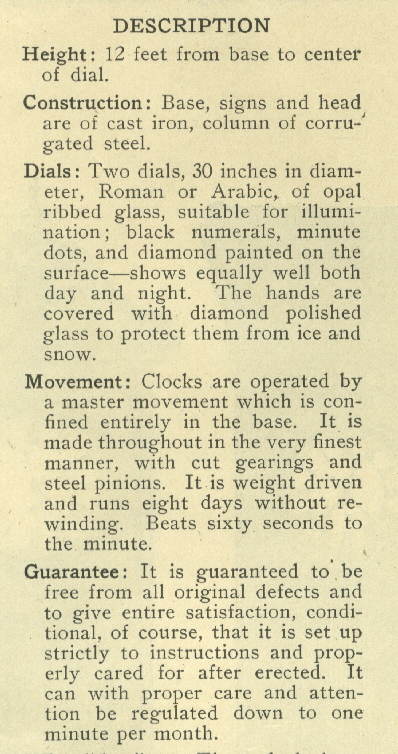
Walter J. Brown died in Nov. 1920 at age 52 and it was reported that his wife, Isabelle C. and children, took over the operation of the Donora store.
Employee, Aderian Ferrier, recalled that the Brown Street Clock Company used the rear portion of this store building as it's warehouse. The iron castings were made by the Old Radiator Works in West Newton, PA. They were brought to the Donora store and the clocks were assembled there.
Lester Hunter recalled that some of the iron castings were also made at the Monessen Foundry.
In 1924, the Brown Street Clock Company was still in business and the name Richard M. Brown appeared on company letterhead. It is uncertain when this company closed, but probably in the mid to late 1920s.
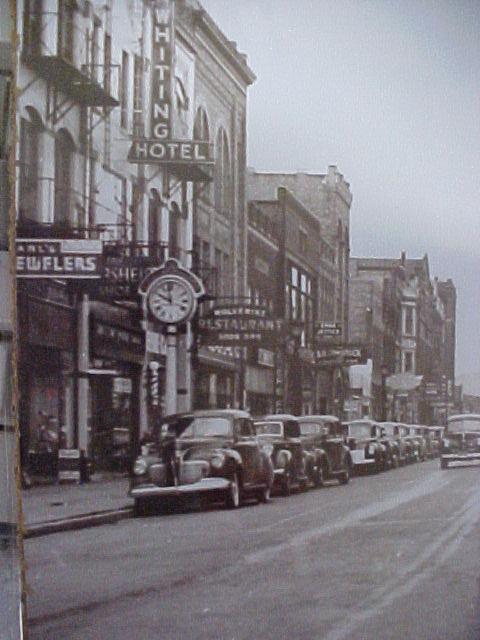
F.A. Earl, Jeweler, downtown Traverse City, Michigan installed this Brown street clock in about 1920. In the 1990's it was moved to 112 N. Washington St. Owosso, Michigan and in 2013, it was relocated to Monessen, PA.

This Brown clock is located in Cedarburg, WI
Circa 1915 Brown Street Clock sales catalog listed the following known locations of Brown Street Clocks:
Salt Lake City, Utah
North Platte, Nebraska
Pueblo, Colorado
Cleveland, Ohio
Selina, Ohio
Newark, Ohio....1915
Montpelier, Ohio
Milwaukee, Wisconsin
Hollidaysburg, PA
Nanticoke, PA
Ford City, PA
Sunbury, PA
Donora, PA
Monessen, PA
Clairton, PA
Medina, Ohio
Barnesville, Ohio
Sistersville, West Virginia
The clock heads of all the Brown Street Clocks were identical throughout production. They were a heavy cast iron with a cast iron dial ring to hold the dial and the protective glass covers over the hands and dial. There is one access panel on the side, for service.
Buyers could order different style top ornaments, which are reviewed below.
The dials were milk glass and the hands were a spade design like the photo below.
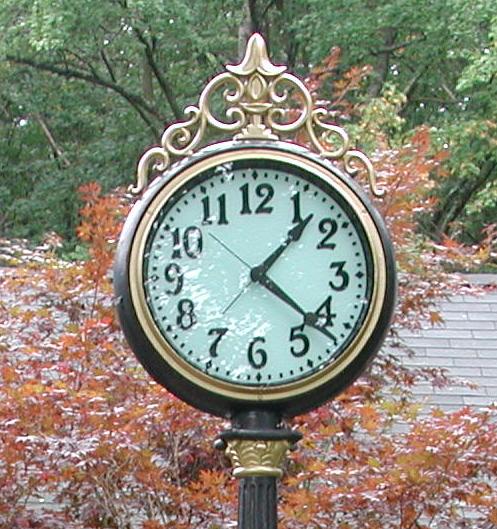
Brown Street Clocks were adorned with three different styles of tops above the round clock head.
All clocks left the factory with one of the toppers. 100 years later, many of the Brown Street Clocks have lost these unique features due to weather, cars knocking the clock over or neglect.
Some owners added other styles, neon marquees or removed the toppers all together. The photos below show the toppers that adorned the clocks as they left the factory.
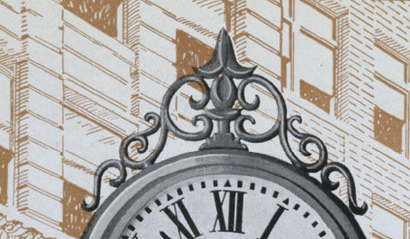

Below is an example of the 'closed crested' topper
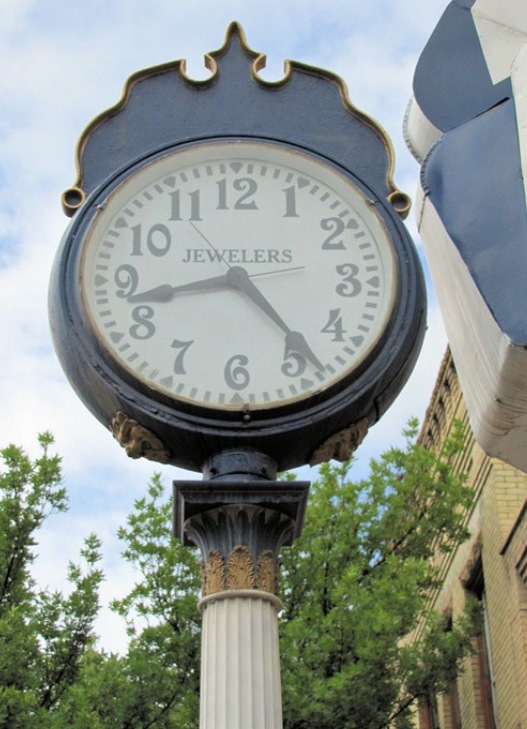
Below is an example of the 'marquee style' topper
These tops were lighted from within and you could order the clock with or without the 4 light globes.

Two of these Lions Heads adorned each Brown Street Clock.
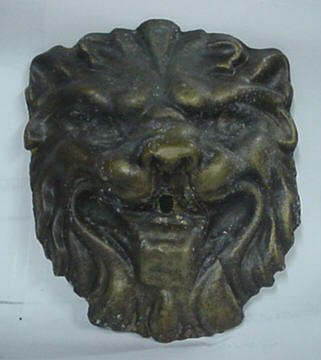
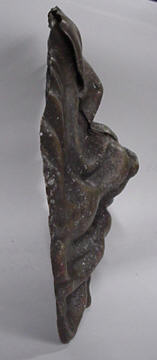
Below, the early style clock head support was a one-piece cast iron unit and was smaller in size.
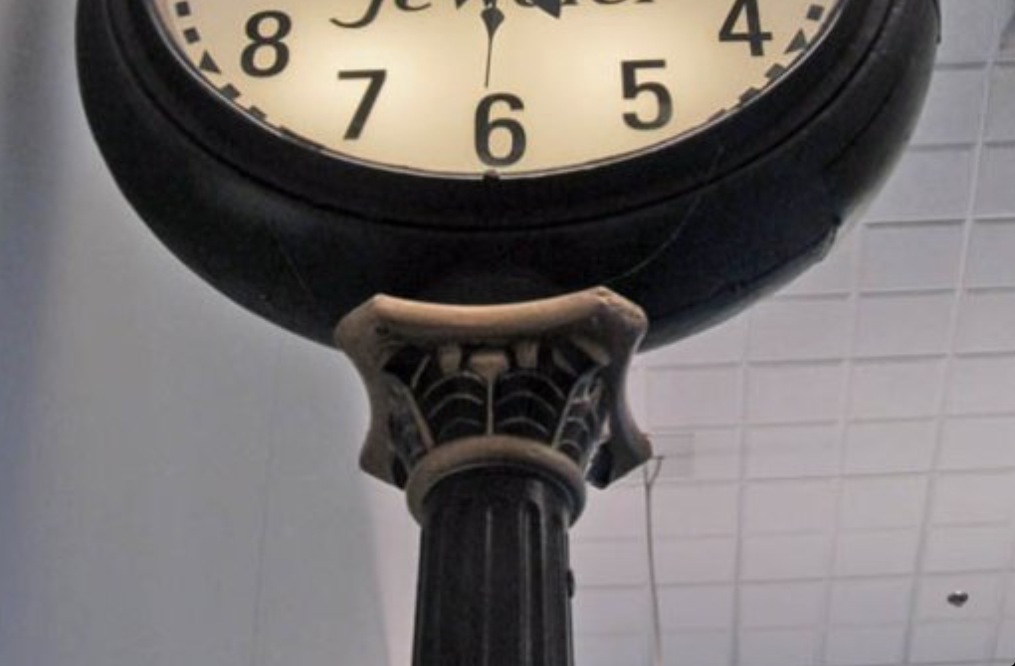
At the top of the column is a cast iron support for the clock head. The support of the later style clock case had the Greek acanthus leafs attached.
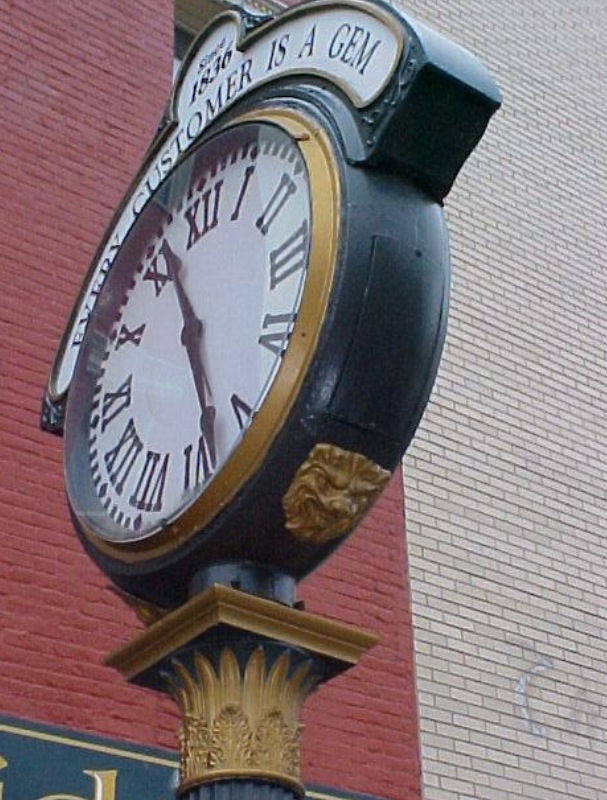
Notice the 3 different column-base designs of the Brown Street clock.
Left: An early style case which has a molded look - cast iron column and cast iron base. No name cast into base.
Middle: Another early style case which has a molded look - cast iron column and cast iron base. Name cast into base.
RIGHT: The later style case - steel fluted column and a cast iron base. Name cast into .
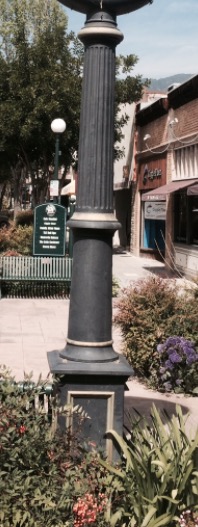
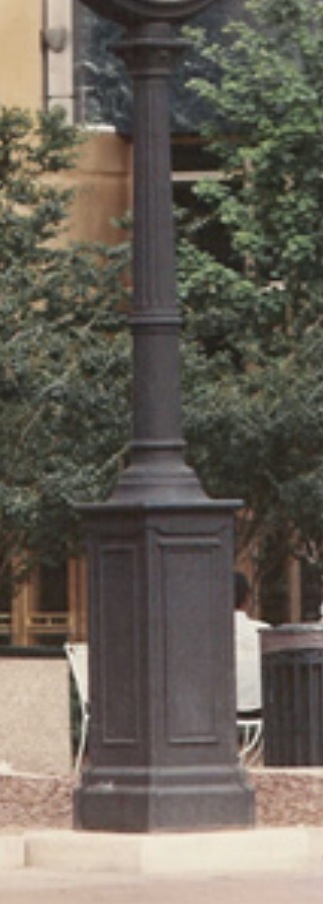

Below, the early style case has no name cast into the base.
This base is the only one of its kind found so far and is in Monrovia, CA and known as the Box Jewelers clock.
This base measures: Cast Iron Column-6', Base Cap-18" square, Base Height-44", Base Width-14 1/4"

Below, the early style case has the name 'Brown Street Clock Co.' on one side of the base and 'Monessen, PA' on the opposite side of the base.
This base measures: Cast Iron Column-?', Base Cap-?" square, Base Height-?", Base Width-?"
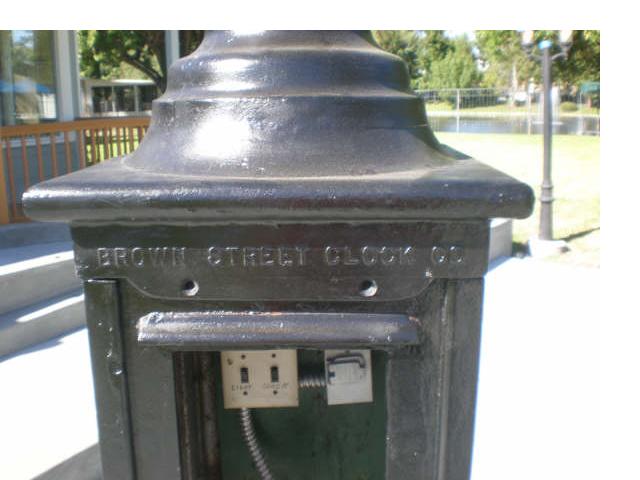
Below, the later style case has the company name and city on one side of base.
The column has been removed from the base in this photo.
This base measures: Steel Fluted Column-4' 6", Base Cap-19 1/2" square, Base Height-51", Base Width-16 1/2"
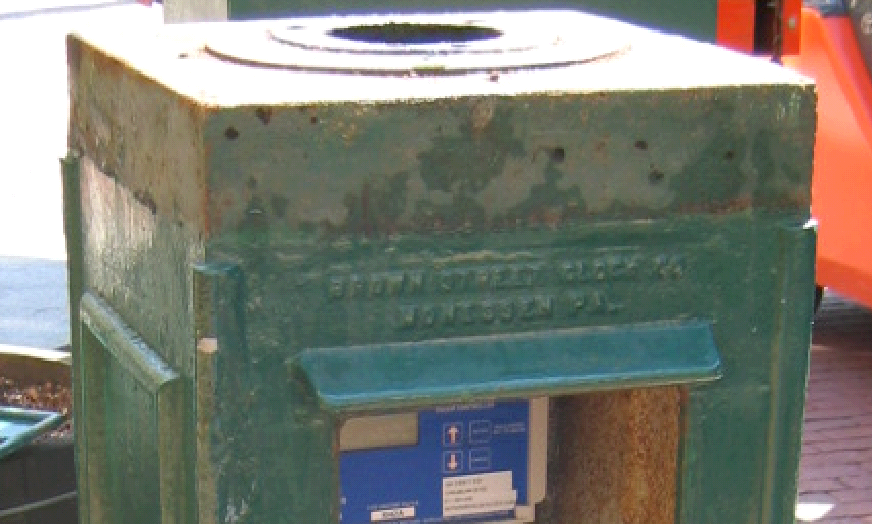
The Brown Street Clock movement is much smaller in size to the E. Howard or Seth Thomas street clock movements.
Below is a nice set-up of the dial gearing - movement - weight.
According to the company literature, "the Master movement is located in the base and runs eight days with one winding. Quality cast brass plates, Graham deadbeat escapement, maintaining power on cable barrel and cast iron motion works mounting bracket.
Electric lights were installed behind dials for illumination and the clock weighs 1,625 lbs. when crated for shipment."
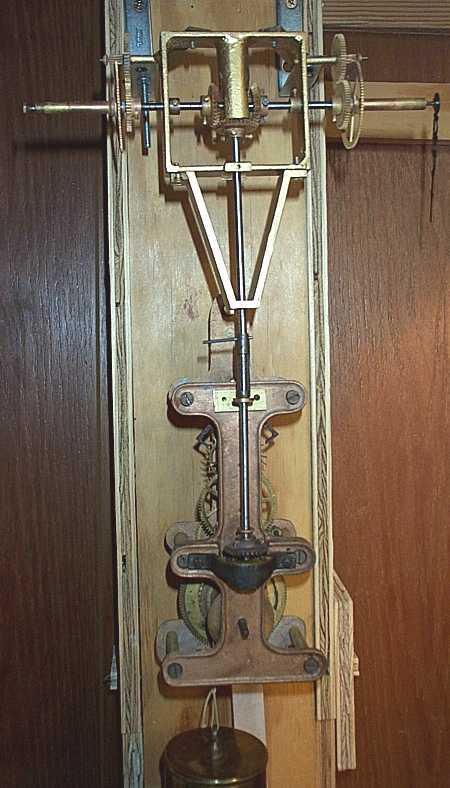
Below shows the set-up of the original movement, weight and pendulum of the Salewsky's Jewelry clock of Centrailia, WA
Two weights were suspended by brass pullys
A long shaft up through the column drives the dial gearing behind the clock dials.
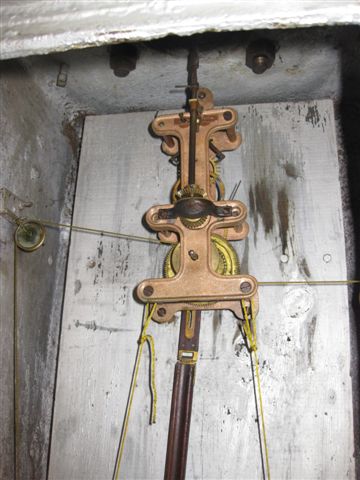
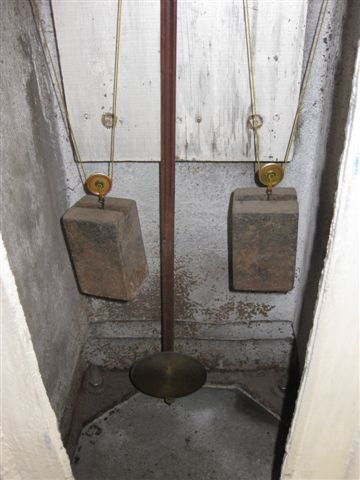
Below are more weight driven movement photos
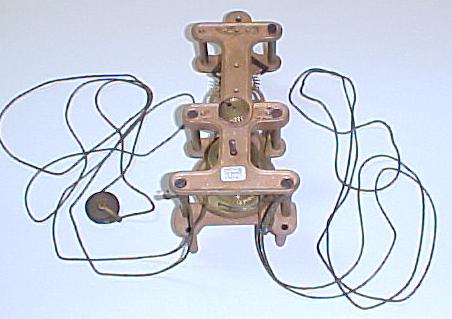
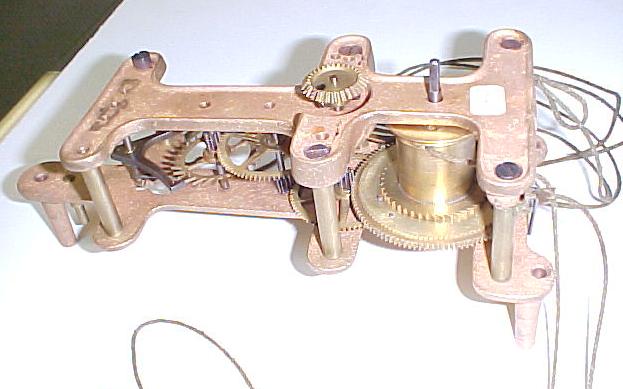
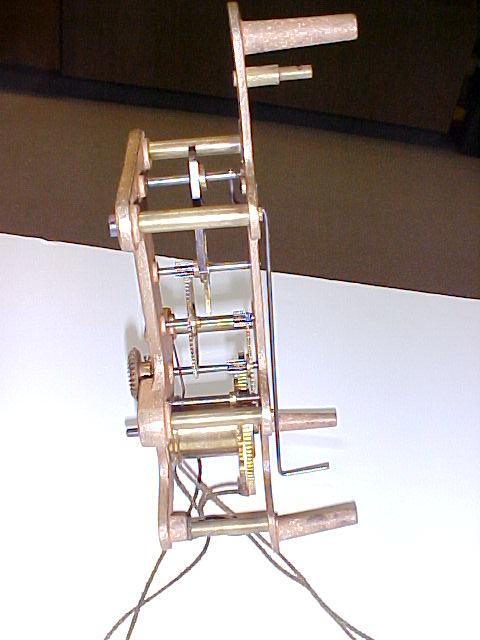
Below are photos showing the cast iron base and
an original movement that has had a 1 rpm electric motor attached.
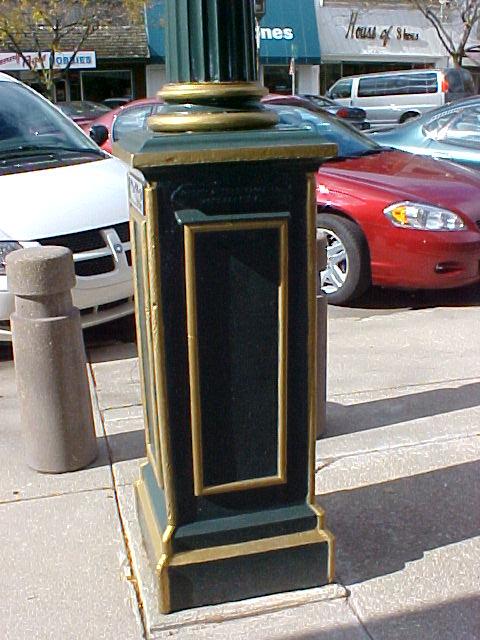
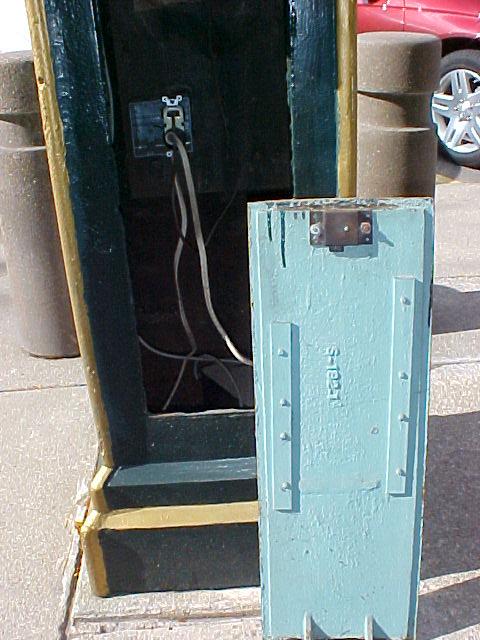
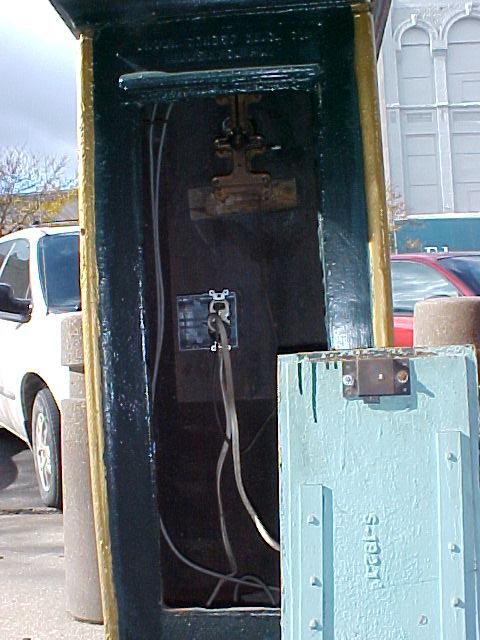
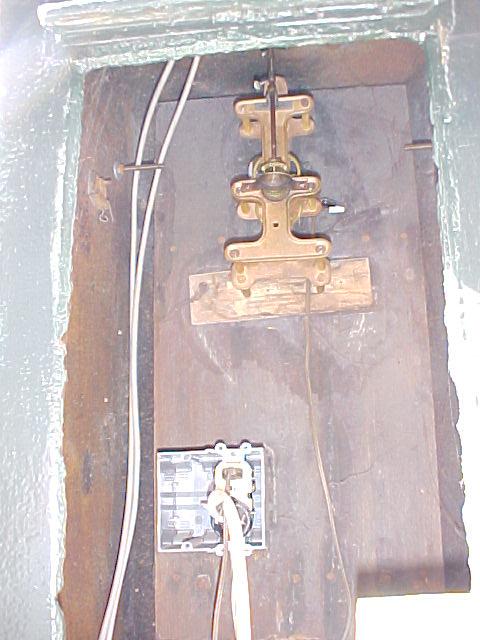
Below, with 1rpm motor attached
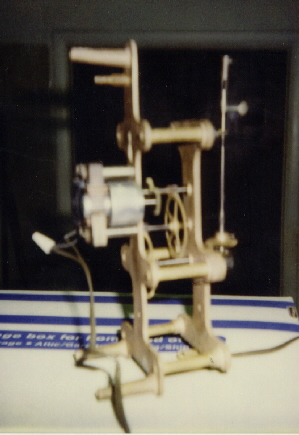
The photo below shows the Brown movement that has an electric winding motor added to it.

Located in Bedminster Township, PA, this beautifully restored Brown Street Clock is owned by Elmer Conti.
Many hours were spent sand blasting, prepping and painting case. Also restoring the movement and dial.
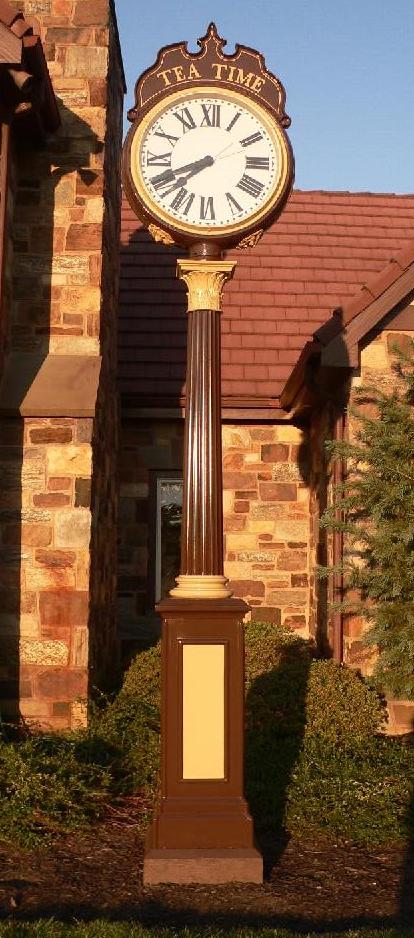
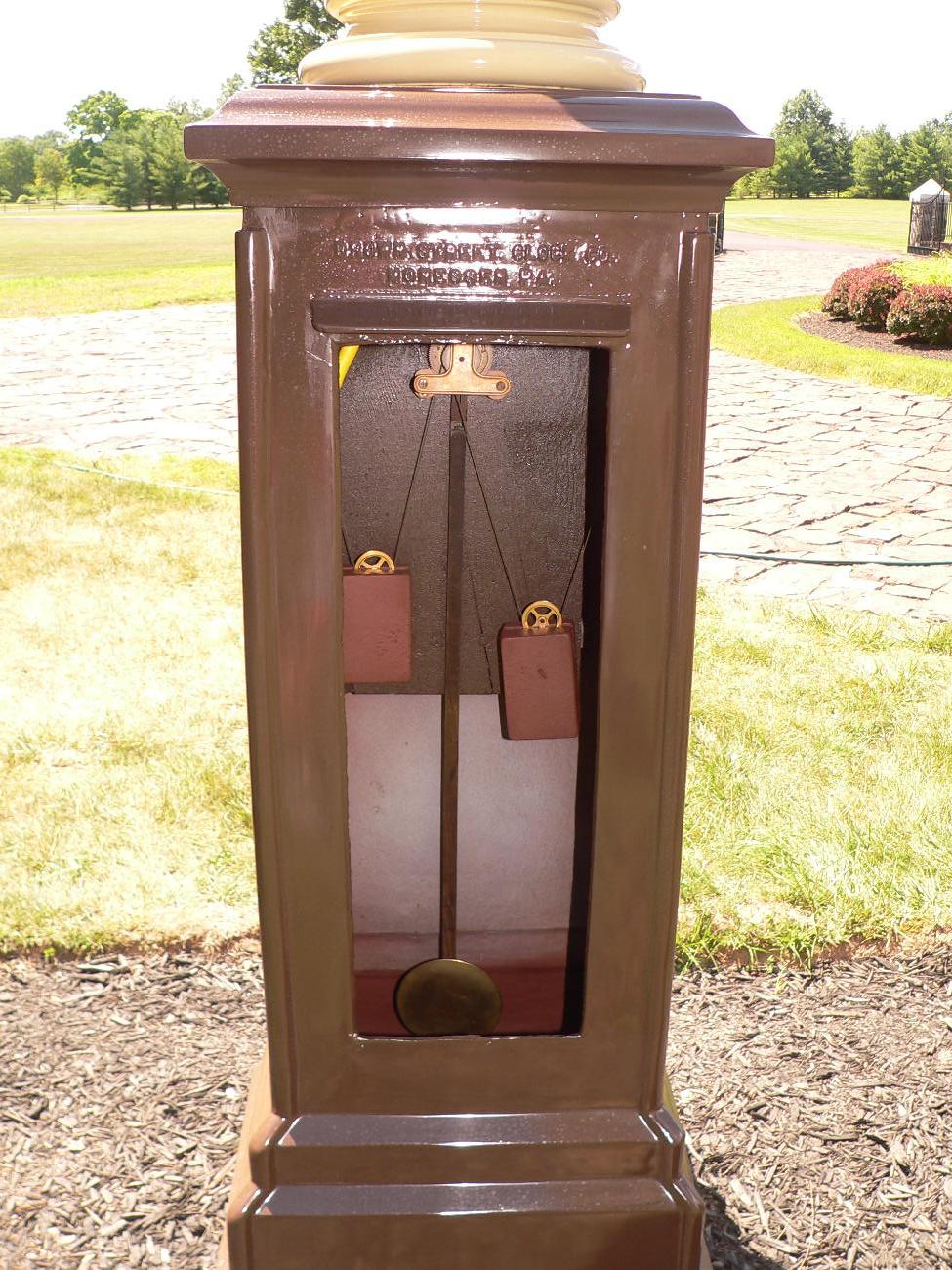
Eric Ryback has reproduced many parts for the Brown Street Clock. These items are available by contacting Eric at:
searuntrout@aol.com
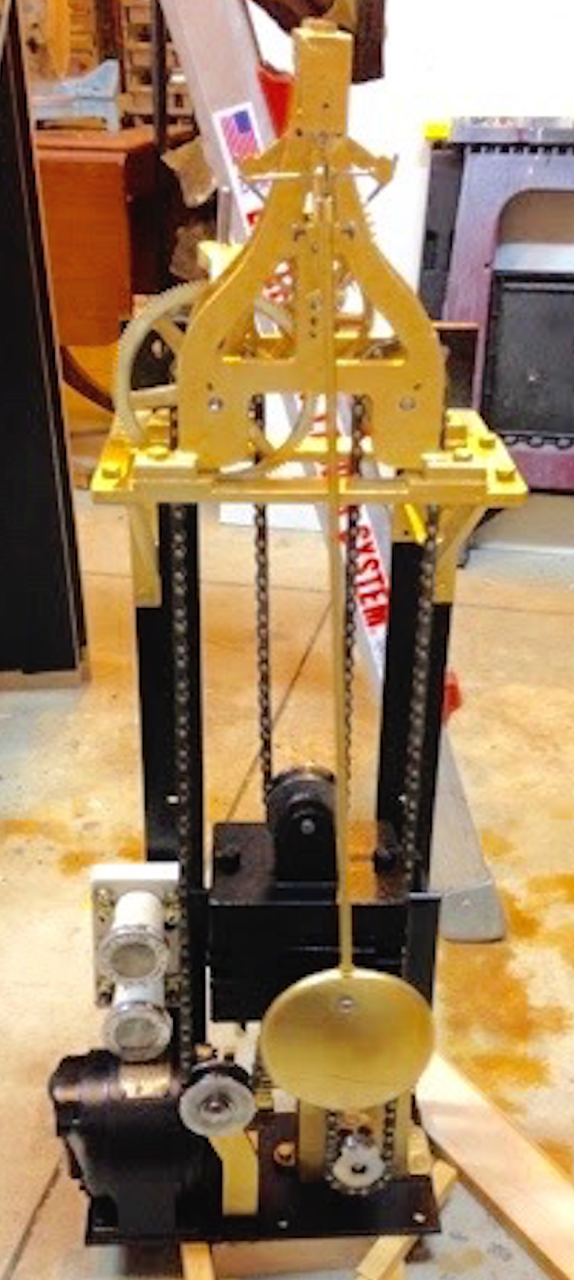
We are always searching for more photos and factory literature of Brown Street Clocks. If you have anything, please scan and email to:
steveschmidt at hotmail.com
The exact location of these Brown Clocks today, is Unknown
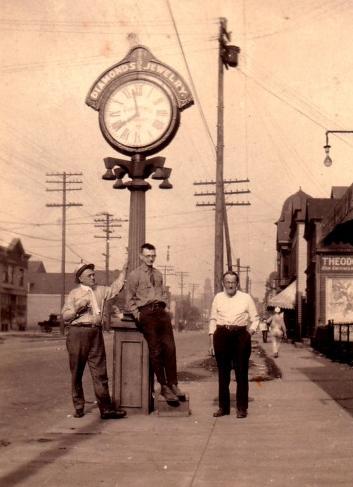
We are always searching for more photos and factory literature from the Brown Clock Company.
If you have anything, please scan and email to:
steveschmidt at hotmail.com
Last Update: 1-09-24......
This is a personal website owned by Steve Schmidt.
Copying any photos and information is prohibited.
Copyright 2024 © All rights reserved